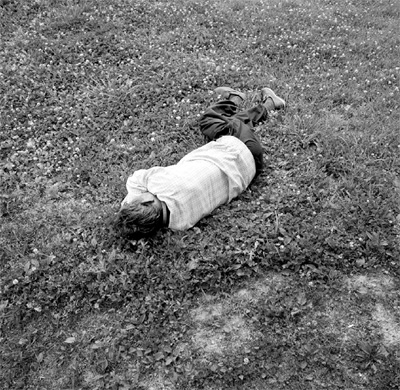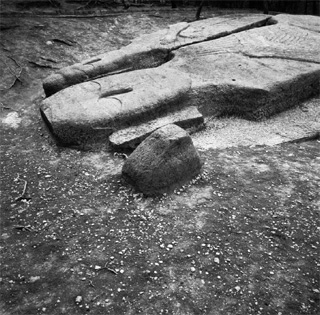Remembering, and forgetting, the Gwangju massacre

Photos of stone Buddhas lying in Unju-sa Temple and a man sleeping in a grass field of the temple, above, are part of Noh Suntag’s solo show “Forgetting Machines,” about the remembering and forgetting of the Gwangju Democratic Movement and its victims.
A collection of black and white portrait photographs now hang on the walls of Hakgojae Gallery in the art zone east of Gyeongbok Palace in central Seoul. The faded, damaged and distorted faces in the photos make for ghostly and haunting images.
They are the works that photographer Noh Suntag has made by retaking funerary photographic portraits put in front of the tombs of those who were killed during the May 18 Gwangju Democratization Movement in 1980. These works carry the images of weathered photos in the old cemetery of Gwangju, without retouches.
They are part of the “Forgetting Machines” series by Noh, who has been dealing with sensitive political issues that straddle the border of photojournalism and fine art. “The Forgetting Machines” is also the title of his solo show at Hakgojae.
“Since democratization, the movement and victims have been officially commemorated, but the remembering has been always accompanied with forgetting,” Noh said at a press preview on Thursday.
“Even documentaries help not only with remembering but also with forgetting. But I don’t intend to criticize forgetting. I just want to show and let people think about what is remembering and what is forgetting and how they coexist now.”

“Park Gui-ju” (2007), top left, and “Hwang Ho-gol” (2006), bottom left, are also part of the series. Provided by Hakgojae Gallery
The exhibition includes not only the portraits but also photos of various landscapes and scenes related to the traces of the Gwangju Democratization Movement. It ends with photos of stone Buddhas lying in Unju-sa Temple in Hwasun County, South Jeolla, and a man sleeping in a grass field of the temple, whose pose resembles that of the Buddhas.
“I heard that many bereaved family members of the victims of the Gwangju massacre visited the temple to seek consolation,” Noh said. “They did so especially because the sculptures of lying Buddhas, which are very unique for Buddha statues not only in Korea but also in other countries, reminded them of their family members lying dead on the streets.

Photos of stone Buddhas lying in Unju-sa Temple
The show runs through June 10. Admission is free. Hours are 10 a.m. to 7 p.m. Tuesdays to Saturdays and to 6 p.m. on Sundays. Go to Anguk Station, line No. 3, exit 2, and walk for 10 minutes. Visit www.hakgojae.com or call (02) 720-1524~6.
By Moon So-young [symoon@joongang.co.kr]










with the Korea JoongAng Daily
To write comments, please log in to one of the accounts.
Standards Board Policy (0/250자)